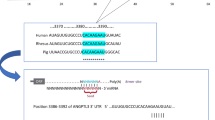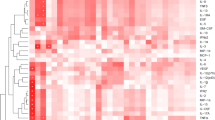Abstract
Background
Infection by Adenovirus 36 (Ad-36) has been associated with adipogenesis using cell and animal models, and a high risk of developing obesity has been reported in Ad-36-seropositive individuals. However, molecular mechanisms involved in the maintenance over the years of adipogenesis associated with Ad-36 has not been investigated in human adipose tissue. Epigenetic mechanisms, such as micro-RNAs (miRNAs) that regulate gene expression at the post-transcriptional level, have shown an important role in the development and maintenance of metabolic diseases.
Aim
This study investigated the expression of miRNA associated with the adipogenic process in visceral adipose tissue from obese individuals according to Ad-36 serology.
Methods
Obese individuals were separated according to their status of Ad-36 serology in seropositive (Ad-36 (+); n = 29) and seronegative (Ad-36 (−); n = 28) groups. Additionally, a group of lean controls (n = 17) was selected to compare with obese individuals. Biopsies of visceral adipose tissue were obtained to evaluate miRNA and gene expression. The study of Ad-36 serology was carried out by ELISA. The expression of pro-adipogenic (miR-17 and miR-210) and anti-adipogenic (miR-155, miR-130 and miR-27a) miRNAs was evaluated using Taqman advanced miRNA assays by qPCR. The expression of adipogenes encoding LEP, ADIPOQ, and PPARγ was evaluated by Taqman predesigned assays through qPCR.
Results
The obese group had higher LEP (p < 0.001) and PPARγ (p = 0.016) expression and lower ADIPOQ expression (p = 0.017), and also had higher expression of miR-210 (p = 0.039), whereas lower expression of miR-155 (p = 0.019) and miR-27a (p = 0.028) as compared to lean controls. Higher PPARγ expression (p = 0.008), but no influence on LEP or ADIPOQ expression was observed in Ad-36 (+) group. Those seropositive individuals also had higher expression of the miR-17 (p = 0.028) and lower levels of miR-155 (p = 0.031) in adipose tissue as compared to seronegative subjects.
Conclusions
Individuals with previous infection by Ad-36 had higher expression of the pro-adipogenic miR-17 and lower expression of the anti-adipogenic miR-155, which could lead to an increased adipogenic status by positively modulating PPARγ expression in adipose tissue from obese subjects.
This is a preview of subscription content, access via your institution
Access options
Subscribe to this journal
Receive 12 print issues and online access
$259.00 per year
only $21.58 per issue
Buy this article
- Purchase on Springer Link
- Instant access to full article PDF
Prices may be subject to local taxes which are calculated during checkout



Similar content being viewed by others
References
Qasim A, Turcotte M, de Souza RJ, Samaan MC, Champredon D, Dushoff J. et al. On the origin of obesity: identifying the biological, environmental and cultural drivers of genetic risk among human populations. Obes Rev. 2018;19:121–49. https://doi.org/10.1111/obr.12625.
Haslam DW, James WP. Obesity. Lancet. 2005;366:1197–209. https://doi.org/10.1016/S0140-6736(05)67483-1.
Guh DP, Zhang W, Bansback N, Amarsi Z, Birmingham CL, Anis AH. The incidence of co-morbidities related to obesity and overweight: a systematic review and meta-analysis. BMC Public Health. 2009;9:88 https://doi.org/10.1186/1471-2458-9-88.
Rogers PM, Fusinski KA, Rathod MA, Loiler SA, Pasarica M, Shaw MK, et al. Human adenovirus Ad-36 induces adipogenesis via its E4 orf-1 gene. Int J Obes. 2008;32:397–406. https://doi.org/10.1038/sj.ijo.0803748.
Pasarica M, Mashtalir N, McAllister EJ, Kilroy GE, Koska J, Permana P, et al. Adipogenic human adenovirus Ad-36 induces commitment, differentiation, and lipid accumulation in human adipose-derived stem cells. Stem Cells. 2008;26:969–78. https://doi.org/10.1634/stemcells.2007-0868.
Akheruzzaman M, Hegde V, Dhurandhar NV. Twenty-five years of research about adipogenic adenoviruses: a systematic review. Obes Rev. 2019;20:499–509. https://doi.org/10.1111/obr.12808.
Kim J, Na H, Kim JA, and Nam JH. What we know and what we need to know about adenovirus 36-induced obesity. Int J Obes. 2020. https://doi.org/10.1038/s41366-020-0536-4.
Atkinson RL, Dhurandhar NV, Allison DB, Bowen RL, Israel BA, Albu JB, et al. Human adenovirus-36 is associated with increased body weight and paradoxical reduction of serum lipids. Int J Obes. 2005;29:281–6. https://doi.org/10.1038/sj.ijo.0802830.
Almgren M, Atkinson R, He J, Hilding A, Hagman E, Wolk A. et al. Adenovirus-36 is associated with obesity in children and adults in Sweden as determined by rapid ELISA. PLoS ONE. 2012;7:e41652. https://doi.org/10.1371/journal.pone.0041652.
Shang Q, Wang H, Song Y, Wei L, Lavebratt C, Zhang F, et al. Serological data analyses show that adenovirus 36 infection is associated with obesity: a meta-analysis involving 5739 subjects. Obesity. 2014;22:895–900. https://doi.org/10.1002/oby.20533.
Sapunar J, Fonseca L, Molina V, Ortiz E, Ines Barra M, Reimer C. et al. Adenovirus 36 seropositivity is related to obesity risk, glycemic control, and leptin levels in Chilean subjects. Int J Obes. 2019. https://doi.org/10.1038/s41366-019-0321-4.
Dhurandhar NV. Insulin sparing action of adenovirus 36 and its E4orf1 protein. J Diabetes Complicat. 2013;27:191–9. https://doi.org/10.1016/j.jdiacomp.2012.09.006.
Lefterova MI, Haakonsson AK, Lazar MA, Mandrup S. PPARγ and the global map of adipogenesis and beyond. Trends Endocrinol Metab. 2014;25:293–302. https://doi.org/10.1016/j.tem.2014.04.001.
Vangipuram. SD, Yu M, Tian J, Stanhope KL, Pasarica M, Havel PJ, et al. Adipogenic human adenovirus-36 reduces leptin expression and secretion and increases glucose uptake by fat cells. Int J Obes. 2007;31:87–96. https://doi.org/10.1038/sj.ijo.0803366.
Karamese M, Altoparlak U, Turgut A, Aydogdu S, Karamese SA. The relationship between adenovirus-36 seropositivity, obesity and metabolic profile in Turkish children and adults. Epidemiol Infect. 2015;143:3550–6. https://doi.org/10.1017/S0950268815000679.
Lee JE, Schmidt H, Lai B, and Ge K. Transcriptional and epigenomic regulation of adipogenesis, Mol Cell Biol. 2019;39. https://doi.org/10.1128/MCB.00601-18.
Huang Q, Ma C, Chen L, Luo D, Chen R, Liang F. Mechanistic insights into the interaction between transcription factors and epigenetic modifications and the contribution to the development of obesity. Front Endocrinol. 2018;9:370. https://doi.org/10.3389/fendo.2018.00370.
Hu Z. Insight into microRNA regulation by analyzing the characteristics of their targets in humans. BMC Genom. 2009;10:594. https://doi.org/10.1186/1471-2164-10-594.
Scheideler M. MicroRNAs in adipocyte formation and obesity. Best Pract Res Clin Endocrinol Metab. 2016;30:653–64. https://doi.org/10.1016/j.beem.2016.11.009.
Zaiou M, El Amri H, Bakillah A. The clinical potential of adipogenesis and obesity-related microRNAs. Nutr Metab Cardiovasc Dis. 2018;28:91–111. https://doi.org/10.1016/j.numecd.2017.10.015.
Son YH, Ka S, Kim AY, Kim JB. Regulation of adipocyte differentiation via microRNAs. Endocrinol Metab. 2014;29:122–35. https://doi.org/10.3803/EnM.2014.29.2.122.
Neville MJ, Collins JM, Gloyn AL, McCarthy MI, Karpe F. Comprehensive human adipose tissue mRNA and microRNA endogenous control selection for quantitative real-time-PCR normalization. Obesity. 2011;19:888–92. https://doi.org/10.1038/oby.2010.257.
Trovato GM, Martines GF, Garozzo A, Tonzuso A, Timpanaro R, Pirri C, et al. Ad36 adipogenic adenovirus in human non-alcoholic fatty liver disease. Liver Int. 2010;30:184–90. https://doi.org/10.1111/j.1478-3231.2009.02127.x.
Cao H. Adipocytokines in obesity and metabolic disease. J Endocrinol. 2014;220:T47–59. https://doi.org/10.1530/JOE-13-0339.
Lafontan M. Adipose tissue and adipocyte dysregulation. Diabetes Metab. 2014;40:16–28. https://doi.org/10.1016/j.diabet.2013.08.002.
Shirani F, Teimoori A, Rashno M, Latifi SM, Karandish M. Using rats as a research model to investigate the effect of human adenovirus 36 on weight gain. ARYA Atheroscler. 2017;13:167–71.
Vogel C, Marcotte EM. Insights into the regulation of protein abundance from proteomic and transcriptomic analyses. Nat Rev Genet. 2012;13:227–32. https://doi.org/10.1038/nrg3185.
Na HN, Hegde V, Dubuisson O, Dhurandhar NV. E4orf1 enhances glucose uptake independent of proximal insulin signaling. PLoS ONE. 2016;11:e0161275. https://doi.org/10.1371/journal.pone.0161275.
Ponterio E, Cangemi R, Mariani S, Casella G, De Cesare A, Trovato FM, et al. Adenovirus 36 DNA in human adipose tissue. Int J Obes. 2015;39:1761–4. https://doi.org/10.1038/ijo.2015.163.
Scott RS. Epstein-Barr virus: a master epigenetic manipulator. Curr Opin Virol. 2017;26:74–80. https://doi.org/10.1016/j.coviro.2017.07.017.
Almouzni G and Cedar H. Maintenance of epigenetic information. Cold Spring Harb Perspect Biol. 2016;8. https://doi.org/10.1101/cshperspect.a019372.
Liu S, Yang Y, Wu J. TNFα-induced up-regulation of miR-155 inhibits adipogenesis by down-regulating early adipogenic transcription factors. Biochem Biophys Res Commun. 2011;414:618–24. https://doi.org/10.1016/j.bbrc.2011.09.131.
Bengestrate L, Virtue S, Campbell M, Vidal-Puig A, Hadaschik D, Hahn P. et al. Genome-wide profiling of microRNAs in adipose mesenchymal stem cell differentiation and mouse models of obesity. PLoS ONE. 2011;6:e21305. https://doi.org/10.1371/journal.pone.0021305.
Skårn M, Namløs HM, Noordhuis P, Wang MY, Meza-Zepeda LA, Myklebost O. Adipocyte differentiation of human bone marrow-derived stromal cells is modulated by microRNA-155, microRNA-221, and microRNA-222. Stem Cells Dev. 2012;21:873–83. https://doi.org/10.1089/scd.2010.0503.
Karkeni E, Astier J, Tourniaire F, El Abed M, Romier B, Gouranton E, et al. Obesity-associated Inflammation Induces microRNA-155 expression in adipocytes and adipose tissue: outcome on adipocyte function. J Clin Endocrinol Metab. 2016;101:1615–26. https://doi.org/10.1210/jc.2015-3410.
Goody D and Pfeifer A, MicroRNAs in brown and beige fat. Biochim Biophys Acta Mol Cell Biol Lipids. 2018. https://doi.org/10.1016/j.bbalip.2018.05.003.
Wang Q, Li YC, Wang J, Kong J, Qi Y, Quigg RJ, et al. miR-17-92 cluster accelerates adipocyte differentiation by negatively regulating tumor-suppressor Rb2/p130. Proc Natl Acad Sci USA. 2008;105:2889–94. https://doi.org/10.1073/pnas.0800178105.
Li H, Li T, Wang S, Wei J, Fan J, Li J, et al. miR-17-5p and miR-106a are involved in the balance between osteogenic and adipogenic differentiation of adipose-derived mesenchymal stem cells. Stem Cell Res. 2013;10:313–24. https://doi.org/10.1016/j.scr.2012.11.007.
An X, Ma K, Zhang Z, Zhao T, Zhang X, Tang B, et al. miR-17, miR-21, and miR-143 enhance adipogenic differentiation from porcine bone marrow-derived mesenchymal stem cells. DNA Cell Biol. 2016;35:410–6. https://doi.org/10.1089/dna.2015.3182.
Garg P, Mazur MM, Buck AC, Wandtke ME, Liu J, Ebraheim NA. Prospective review of mesenchymal stem cells differentiation into osteoblasts. Orthop Surg. 2017;9:13–19. https://doi.org/10.1111/os.12304.
Modica S, Wolfrum C. Bone morphogenic proteins signaling in adipogenesis and energy homeostasis. Biochim Biophys Acta. 2013;1831:915–23. https://doi.org/10.1016/j.bbalip.2013.01.010.
Liang WC, Wang Y, Wan DC, Yeung VS, Waye MM. Characterization of miR-210 in 3T3-L1 adipogenesis. J Cell Biochem. 2013;114:2699–707. https://doi.org/10.1002/jcb.24617.
Lee EK, Lee MJ, Abdelmohsen K, Kim W, Kim MM, Srikantan S, et al. miR-130 suppresses adipogenesis by inhibiting peroxisome proliferator-activated receptor gamma expression. Mol Cell Biol. 2011;31:626–38. https://doi.org/10.1128/MCB.00894-10.
Kim SY, Kim AY, Lee HW, Son YH, Lee GY, Lee JW, et al. miR-27a is a negative regulator of adipocyte differentiation via suppressing PPARgamma expression. Biochem Biophys Res Commun. 2010;392:323–8. https://doi.org/10.1016/j.bbrc.2010.01.012.
Lin Q, Gao Z, Alarcon RM, Ye J, Yun Z. A role of miR-27 in the regulation of adipogenesis. FEBS J. 2009;276:2348–58. https://doi.org/10.1111/j.1742-4658.2009.06967.x.
Acknowledgements
We thank the volunteers for their participation in this research. We also thank physicians, nurses, and administrative staff from the Centro de Tratamiento de la Obesidad and the Laboratorio Clínico of the Clínica Alemana de Temuco. We thank Dr. Soledad Reyes and Lilian Saravia for the support in obtaining biological samples. This research was funded by FONDECYT-Chile (grant number 11150445) and CONICYT-Chile (grant number REDI170632).
Author information
Authors and Affiliations
Corresponding author
Ethics declarations
Conflict of interest
The authors declare that they have no conflict of interest.
Additional information
Publisher’s note Springer Nature remains neutral with regard to jurisdictional claims in published maps and institutional affiliations.
Rights and permissions
About this article
Cite this article
Manríquez, V., Gutierrez, A., Morales, A. et al. Influence of adenovirus 36 seropositivity on the expression of adipogenic microRNAs in obese subjects. Int J Obes 44, 2303–2312 (2020). https://doi.org/10.1038/s41366-020-00654-9
Received:
Revised:
Accepted:
Published:
Issue Date:
DOI: https://doi.org/10.1038/s41366-020-00654-9



